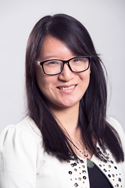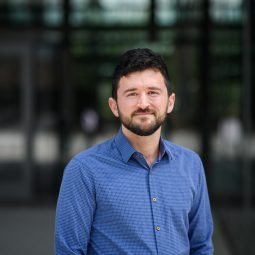

Thursday, December 16, 3:30-4:30pm, WEL 2.122
Postdoctoral Research Associate, Beckman Institute
University of Illinois Urbana Champaign
PhD, Minnesota, 2018
Abstract: The dynamics between the environment, host and microbes have huge implications for both sustainability and human health. Understanding the molecular basis of how microbiota impact the host response to environmental exposure are critical to develop effective strategies for risk assessment, pollution control and precision medicines. In this seminar, I will introduce my previous work on nano-bio and host-microbe interactions, building towards my future research program to decipher the molecular basis of the environment-host-microbe interactions. The rapidly advancing field of nanotechnology poses challenges for timely and predictive risk assessment of highly reactive nanomaterials being released into the environment. Focusing on an emerging nanoscale battery material, we investigated DNA damage as a shared toxicity mechanism in two bacteria and revealed unprecedented details on DNA modification after nanomaterial exposure as well as biological responses relating to DNA damage. Expanding my research to the host-microbe interactions, my current work investigates the role of D-amino acids, particularly D-alanine (D-Ala), as microbe-originated signaling molecules in the microbiome-gut-brain axis. Using nematode Caenorhabditis elegans and Escherichia coli bacterial mutants, I found impact of bacterial D-Ala synthesis and metabolism on animal phenotypes under normal condition and high glucose exposure. Using germ-free mice, I revealed biodistribution and sources of D-Ala in higher animals. As my previous studies have provided new biomarkers for nanomaterial risk assessment and indicated new targets for microbiota-mediated intervention of diseases, my future research will combine my previous trainings to investigate the molecular basis of the environment-host-microbe interactions.
Publications (Google Scholar Citations)
ORCiD: https://orcid.org/0000-0002-7254-9233
h-index: 10 Total Articles: 16 Total Citations: 416 (Web of Science, Dec. 2021)
h-index: 12 Total Citations: 527 (Google Scholar Citations, Nov. 2021)
Tuesday, December 14, 3:30-4:30pm, WEL 2.122
Postdoctoral Fellow
University of California Berkeley
PhD, MIT, 2019
Publications (Google Scholar Citations)
h-index: 9 Total Articles: 12 Total Citations: 296 (Web of Science, Dec. 2021)
h-index: 9 Total Citations: 360 (Google Scholar Citations, Nov. 2021)
Wednesday January 27, 3:30-4:30, ZOOM
Postdoctoral Researcher
Weill Cornell Medicine
PhD, Univ. of Pennsylvania, 2017
Abstract: The advent of high-speed atomic force microscopy (HS-AFM) has opened a new era in molecular biophysics for watching single bio-molecules in action at the membrane at high spatial-temporal resolution: Membrane protein diffusion, assembly, structural dynamics, and conformational changes now could be directly visualized and studied. Further developments in environmental control (temperature, force, light, and buffer conditions) and fast-scanning submodes expand HS-AFM's applicability to study biomolecular dynamics spanning from seconds to microseconds in different biochemical conditions. This talk will exemplify HS-AFM's power for the quantitative analysis of function-related structural dynamics on membrane proteins. The first part of my talk will focus on the discovery of conformational changes in mechanosensitive Piezo1 ion channel in response to the force application, which mediates the force-detection in many eukaryotic cells. I will then discuss the physiological role of the Ca2+-triggered membrane-binding protein Annexin-V during the membrane repairing processes when cell injuries. The newfound understanding of membrane proteins' structure-function relationship could shed light on novel strategies to develop drug treatments currently not readily available.
Publications (Google Scholar Citations)
ORCID: https://orcid.org/0000-0002-6498-215X
h-index: 13 Total Articles: 21 Total Citations: 643 (Web of Science, Jan. 2021)
h-index: 13 Total Citations: 703 (Google Scholar Citations, Jan. 2021)
Monday, January 25, 3:30-4:30, ZOOM
Postdoctoral Fellow
Princeton University
PhD, Michigan, 2018 (Nathaniel Szymczak)
Abstract: The spatial relationships between biomolecules define the structure of life. Consequently, new technologies that can reveal these relationships with increased precision deepen our understanding of biology and create avenues of inquiry which would be otherwise unavailable. Proximity-based labeling, in which chemically reactive tags are generated at a protein of interest and then label nearby biomolecules for MS-based identification, is a conceptually powerful way to leverage spatial relationships between proteins to discover protein-biomolecule interactions. Widely used proximity labeling technologies currently use enzymatically generated electrophilic biotin-AMP and phenoxyl radicals as reactive tags, which can undergo long-range diffusion in water and have limited spatial resolution. After an overview of my graduate work in inorganic chemistry and organic methodology, I will describe the development of a new, higher resolution proximity labeling approach which instead uses more reactive biotin-carbene species incapable of diffusion through water, termed µMap. This technology uses antibodies conjugated to iridium-based photocatalysts to catalytically activate diazirines via Dexter energy transfer, converting them to carbenes which crosslink only to proteins that are adjacent to the antibody binding target. This technique was then used to label proteins colocalized with a variety of receptors on the surface of live lymphocytes, such as PD-L1, CD45, and CD300A, and was capable of distinguishing between receptor interactomes which could not be disentangled using traditional phenoxyl radical proximity labeling. Using small molecule probes in place of antibodies, the tight labeling radius enabled efficient chemoproteomic target ID and the identification of amino acids adjacent to their binding sites. This photocatalytic proximity labeling strategy is highly general, and represents a new level of spatial resolution in the discovery of protein-protein interactions.
Publications (Google Scholar Citations)
h-index: 7 Total Articles: 12 Total Citations: 281 (Web of Science, Jan. 2021)
h-index: 8 Total Citations: 344 (Google Scholar Citations, Jan. 2021)
Wednesday, January 20, 3:30-4:30, ZOOM
Postdoctoral Fellow
Harvard University, Brigham & Women's Hospital
PhD, UC Irvine 2018 (Reg Penner)
Abstract: The field of bioanalytical sensors for protein detection has progressed immensely over the past decade, resulting in research tools that directly impact our understanding of human diseases. Dr. Ogata’s seminar will focus on her PhD and postdoctoral research, which has focused on the development of novel bioanalytical technologies for disease diagnostics. During her PhD at UC Irvine, Dr. Ogata developed simple and rapid sensors for the detection of proteins using electrochemical methods and pioneered the “virus bioresistor” , a sensor platform that continues to be developed for the detection of bladder cancer markers in urine. As a postdoctoral fellow at UC Irvine, Dr. Ogata studied the formation mechanisms of biological-synthetic nanomaterials using cryogenic transmission electron microscopy. The use of cryoTEM enabled the direct observation of several precursor phases that play an important role in crystal formation and protein encapsulation. Currently, Dr. Ogata is a postdoctoral fellow at the Brigham and Women’s hospital working on the development of ultrasensitive protein assays using single-molecule array technology. In collaboration with clinicians, she recently developed an ultrasensitive assay for the detection of SARS-CoV-2 antigens in the blood of COVID-19 patients. These viral antigens show correlation with disease severity and respiratory failure, and the assays are currently being developed as a prognosis tool for doctors in the intensive care unit.
Publications (Google Scholar Citations)
h-index: 8 Total Articles: 18 Total Citations: 224 (Web of Science, Dec. 2020)
h-index: 9 Total Citations: 304 (Google Scholar Citations, Dec. 2020)
Wednesday, January 13, 3:30-4:30, ZOOM
Postdoctoral Scholar (Pharmaceutical Chemistry)
UC San Francisco
PhD, Wisconsin, 2016 (Ronald Raines)
I am broadly interested in how the intrinsic, chemical properties and features of proteins bias them toward specific structures, particularly the amyloid state implicated in many neurodegenerative disorders. My work integrates approaches and perspectives from the fields of biophysics and chemical biology to dissect the determinants of folding and misfolding in proteins linked to human diseases like Alzheimer's or Parkinson's. Understanding what makes proteins susceptible or resistant to misfolding will inform strategies for targeted intervention.
Publications (Google Scholar Citations)
ORCID: https://orcid.org/0000-0002-2020-2641
h-index: 12 Total Articles: 16 Total Citations: 684 (Web of Science, Dec. 2020)
h-index: 14 Total Citations: 888 (Google Scholar Citations, Dec. 2020)
Monday, January 11, 3:30-4:30, ZOOM
American Cancer Society Postdoctoral Fellow
Northwestern University
PhD, UC San Diego, 2018 (Nathan Gianneschi)
Bio: Following the completion of her B.S. in Biochemistry (2012) at West Chester University, Cassandra earned both her M.S. (2014) and Ph.D. (2018) in Chemistry at the University of California, San Diego under the guidance of Prof. Nathan Gianneschi. At UC San Diego, she elucidated fundamental molecular design parameters for the synthesis of biohybrid materials that site-specifically interact with proteins, cells, and tissues with high affinity. Her graduate work was supported by fellowships from the Inamori Foundation, the ARCS Foundation, and the Cancer Researchers in Nanotechnology program (NIH R25T). Cassandra was recognized for her thesis research with an Outstanding Dissertation Award from the UC San Diego Department of Chemistry and Biochemistry in 2018. She is currently an American Cancer Society Postdoctoral Fellow in Prof. Chad Mirkin's research group at Northwestern University (previously: Eden & Steven Romick IIN Fellow at Northwestern University). At Northwestern, her research has revealed that the chemical composition of vaccine components, coupled with their the three-dimensional nanoscale arrangement, determines their physical stability and release kinetics in biological media, which in turn dictates the kinetics of cellular signaling and overall immunotherapeutic function. For her work as an early career researcher, Cassandra was selected as a 2019 CAS Future Leader by the Chemical Abstracts Service of the American Chemical Society.
Publications (Google Scholar Citations)
ORCID: https://orcid.org/0000-0003-1561-3240
h-index: 6 Total Articles: 12 Total Citations: 488 (Web of Science, Dec. 2020)
h-index: 7 Total Citations: 793 (Google Scholar Citations, Dec. 2020)
The Seminars page is brought to you by the University Libraries. Our intent is to provide a quick profile of our guest speakers, links to their research group sites, recent publications, author metrics, and other information to enhance your engagement with the guests.

This work is licensed under a Creative Commons Attribution-NonCommercial 4.0 Generic License.